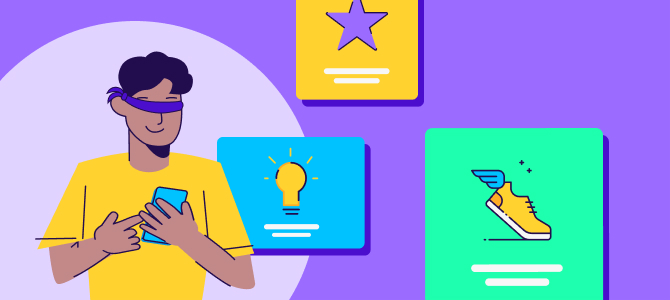
Identifier for advertisers (IDFA)

Identifier for Advertisers, or IDFA for short, is a unique, random identifier (device ID) that Apple assigns to every iOS device. An IDFA would be the equivalent of a web cookie, in the sense that it enables advertisers to monitor users’ engagement with their ads, and keep track of their post-install activity.
What is IDFA?
Much like Google’s cookies, Apple’s IDFA was originally designed to allow advertisers to measure their campaigns’ performance and user journeys.
Unlike browser cookies, however, which have a relatively short lifespan, an IDFA sticks around until a user decides to manually reset or disable it, i.e. turn on Limit Ad Tracking (LAT).

LAT is a privacy feature on Apple devices that has been around since 2016, which allows users to choose whether or not advertisers can receive data about activity generated by their devices.
When turned on, LAT zeros users’ IDFA, which means that instead of a string of numbers — measurement providers receive a string of zeros for a given Device ID.
Post Apple’s ecosystem-shaking move to make iOS more privacy-centric, the App Tracking Transparency Framework, or ATT, puts the option of device ID-based measurement in users’ hands, offering them the choice to opt-in (instead of the traditional opt-out).
IDFA after iOS 14
Apple’s move towards user privacy dramatically limited advertisers’ ability to rely on IDFA for mobile campaign measurement.
That said, it’s worth mentioning that the IDFA isn’t dead. In fact, the latest statistics put ATT opt-in rates at around 46%.
While Apple offers their own attribution solution called SKAdNetwork (or SKAN, for short), which is a way for advertisers to measure ad impressions and clicks-to-app installs on iOS without infringing on user-level or device-level privacy — it’s far from perfect.
Not having the ability to measure the following poses major challenges for advertisers:
- No LTV or real ROI measurement – SKAdNetwork measures mostly installs, conversion values, and post-install data, but in a very limited, time-restrictive way.
- Lack of granularity – Data is limited to campaign level and only to 100 campaigns (at least until the release of SKAN 4.0).
- Postback delay – SKAN 4.0 will enable advertisers to receive up to 3 postbacks, each based on a specific activity window (0-2 days, 3-7 days and 8-35 days). Although an improvement compared to the previous version, postback delays still pose a challenge for advertisers.
- Ad fraud risk – Data can easily be manipulated in transit.
- Lack of re-engagement attribution – which disables advertisers’ ability to plan, measure, and optimize their iOS remarketing activities.
How does the limited access to IDFA impact advertisers & publishers?

When IDFA is available for advertisers, it’s highly useful for campaign measurement.
For example, when users click a banner ad, play a video, or install an app, ad networks pass their IDFA with the relevant data. And although not all ad networks pass IDFAs to advertisers, but allow them to target specific IDs within their properties — most ad networks do.
IDFAs were also used as a way to detect ad fraud. By monitoring their stream of ad actions and their associated IDFAs, advertisers were able to get important signals that flagged fraudulent activities. Nowadays, the majority of anti-fraud logic relies on statistical, large scale thresholds that rarely rely on individual device IDs.
Simply put, not being able to access IDFAs as freely as before, impacts advertisers’ ability to engage their audiences, create personalized experiences, and measure their campaign effectiveness.
Some of the ways in which advertisers and publishers are impacted by the IDFA scarcity include:
- Measurement – Given that advertisers lost their visibility into events such as clicks, downloads, registrations, and purchases in the case of non-consenting users — the ability to track conversion has become more limited.
- Targeting & remarketing – Although advertisers are still able to send in-app notifications on their iOS apps, they’ve lost the ability to identify individual users, unless they’ve actively opted in.
- Personalization – Without access to IDFA, advertisers lose some of their ability to personalize, run effective A/B testing, and continuously optimize their creative messaging when aiming to engage specific audiences.
SKAdNetwork – Apple’s privacy-centric API
First introduced by Apple in 2018, the SKAdNetwork framework is a type of direct install attribution. It was developed to provide privacy-preserving, accurate attribution for iOS campaigns to advertisers — without revealing any user-level or device-specific data.
There are two types of engagements that SKAdNetwork registers:
- Views – whether an ad was viewed
- StoreKit renders – whether or not a StoreKit rendering was generated.
Since we’re living in a highly dynamic ecosystem that never stops evolving, let’s explore a few of the key changes brought about by iOS 15, SKAN 4.0, and how you can make the most of both as an advertiser.
iOS 15 updates
Conversion value endpoint configuration
Before iOS 15, SKAN postbacks were sent only to ad networks, and then forwarded to the advertiser or MMP on the advertiser’s behalf.
Starting with iOS 15 and moving forward, however, advertisers are given direct access to SKAdNetwork postbacks, and a much-deserved ownership of their data.
By configuring their MMP as an endpoint, the MMP:
- Provides advertisers full flexibility around designing, testing, managing, and optimizing their conversion value logic.
- Validates postbacks against those reported by the ad network.
- Connects ad network campaign name, ad set name, and ad name to the SKAdNetwork-reported campaign.
- Connects pre-install campaign data such as cost, clicks and impressions.
- Displays the data in SKAdNetwork’s dashboard as well as SKAdNetwork APIs.
- Prevents and blocks SKAdNetwork fraud.
SKAdNetwork 4.0
In WWCD 2022, Apple announced the next version of SKAN, which introduces significant changes that will allow advertisers and ad networks to measure more while maintaining user privacy.
Here’s a recap of the four most fundamental updates and what each one actually means:
- Three postbacks instead of one – Advertisers will be able to receive up to 3 postbacks (instead of just 1 in the previous version), each based on a specific activity window: 0-2 days, 3-7 days and 8-35 days. This will allow advertisers to understand how users engage with their app overtime.
Note that although these three postbacks will not be connected and tied to an individual, advertisers will still be able to count unique event occurrences.
- Crowd anonymity – A new term that Apple uses to describe the privacy-preserving way in which SKAN delivers attribution data. In short: the more installs you get, the more data you have.
- Hierarchical conversion values – In the current version of SKAdNetwork, postbacks include a conversion value only in cases where Apple’s privacy threshold is met. When crowd anonymity is low, Apple takes extra precautions to protect user privacy by masking the conversion value and source app ID.
SKAN 4.0 introduces a new set of “coarse-grained” conversion values (in addition to the “fine-grained” 64 values that exist today), which means that conversion values are now split into 3 types: low, medium, or high — each assigned by advertisers to indicate different levels of user engagement. This allows advertisers to receive some attribution data in cases where the privacy threshold hasn’t been met.
- Hierarchical source identifier – From SKAN 4.0 onward, Apple will rename their campaign identifier field to source identifier, and increase its range from 2 digits (representative of 100 options) to 4 digits (representative of 10,000 options).
Hierarchical source identifiers also adhere to Apple’s privacy threshold — meaning the higher the level of crowd anonymity, the higher the level of granularity would be.
How did the post-ATT IDFA impact Facebook and Google?

The aftershocks created by Apple’s ATT and the subsequent decline of the IDFA, continue to generate major challenges for advertisers and ad networks alike.
When comparing pre-ATT to post-ATT market share (H1 2020 & H1 2022 respectively) using AppsFlyer’s Single Source of Truth (SSOT) logic, which combines and dedupes data from SKAN and AppsFlyer’s attribution — we can see that Meta lost a significant share of its iOS install market share.
Google, in turn, has also lost considerable ground. And although both self-reporting network giants were negatively impacted, ATT has evidently been much more painful for Meta, based on the company’s earnings reports and numerous articles in the press.
Back in 2020, the social network dominated iOS, but nowadays the company is nowhere near where it used to be prior to Apple’s privacy changes in terms of market share.
Before ATT came into effect, Meta was way ahead of the competition with unrivaled user level data-driven optimization. iOS 14 made the social media titan lose that competitive edge, and with SKAN leveling the playing field in some ways — Meta had the most to lose.
For Google, however, iOS is secondary compared to Android, especially compared to the company’s massive web business. Unlike Meta whose main assets are apps (facebook, Instagram, Whatsapp, etc.), Google’s main asset is search — a mobile web environment where the ATT prompt is irrelevant.
The future of a post-IDFA world
As the ecosystem evolves and alternative solutions mature, IDFA is destined to become less and less relevant in the realms of mobile measurement.
It will give way to solutions that involve cohort analysis, data clean rooms, machine learning, predictive analytics, and top-down measurement such as incrementality and media mix modeling (MMM).
To make the most of this new reality, advertisers should also warm up to SKAN measurement and learn how to make it work for them.
How can advertisers make the most of SKAdNetwork in an IDFA-less ecosystem?
Here are a few steps to ensure your business is SKAN-ready:
- Data aggregation – Be sure to collect all SKAdNetwork information from each ad network.
- Data validation – Ensure all postbacks are signed by Apple and aren’t manipulated in transit. Working with a trusted MMP can help you address this with ease.
- Data enrichment – Match SKAN information with other data points, such as impressions, clicks, cost, and organic traffic — for a complete ROI analysis.
- Data enablement – Make sure SKAdNetwork data is available for convenient consumption by using your MMP’s dedicated dashboards and APIs.
- Seamless integration – Make sure your MMP solution offers a full and tight integration with SKAN, which will require close to zero effort on your end and get you all geared up towards future changes in the SKAdNetwork protocol.
- Conversion events – Be sure to measure server side, dynamic, and flexible in-app events.
Key takeaways
An IDFA is a unique device ID that Apple assigns to every iOS device, which enables advertisers to monitor users’ engagement with their ads, and keep track of their post-install activity.
Given Apple’s ATT framework and the severe limitation of IDFA post iOS 14:
Measurement – advertisers are struggling to measure LTV and ROI in SKAN, are lacking granularity, and the ability to track conversion has become more limited.
Targeting & remarketing – advertisers lost the ability to identify individual users, unless they’ve actively opted in, and are unable to plan, measure, and optimize their iOS remarketing activities.
Fraud – advertisers are dealing with increasing levels of ad fraud in SKAdNetwork.
Personalization – advertisers lost some of their ability to personalize, run effective A/B testing, and continuously optimize their creative messaging.
Apple’s announcement of SKAN 4.0, has introduced significant changes that will allow advertisers and ad networks to measure more while maintaining user privacy. These updates will help advertisers measure more despite the loss of IDFA.
As the ecosystem evolves and alternative solutions mature, IDFA is destined to become less and less relevant in the realms of mobile measurement.
It will give way to solutions that involve cohort analysis, data clean rooms, machine learning, predictive analytics, and top-down measurement — giving advertisers the tools they need to plan, measure, and optimize their campaigns, while preserving their users’ privacy in full.



